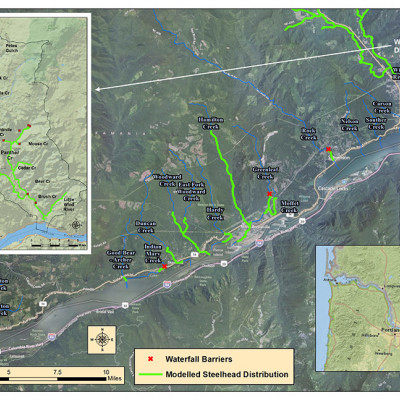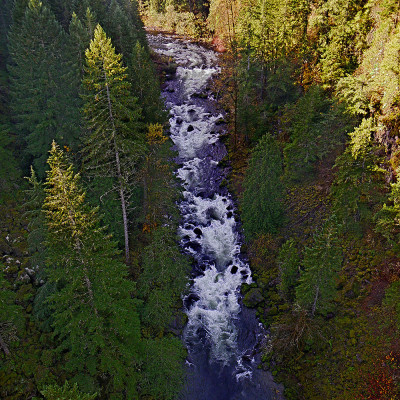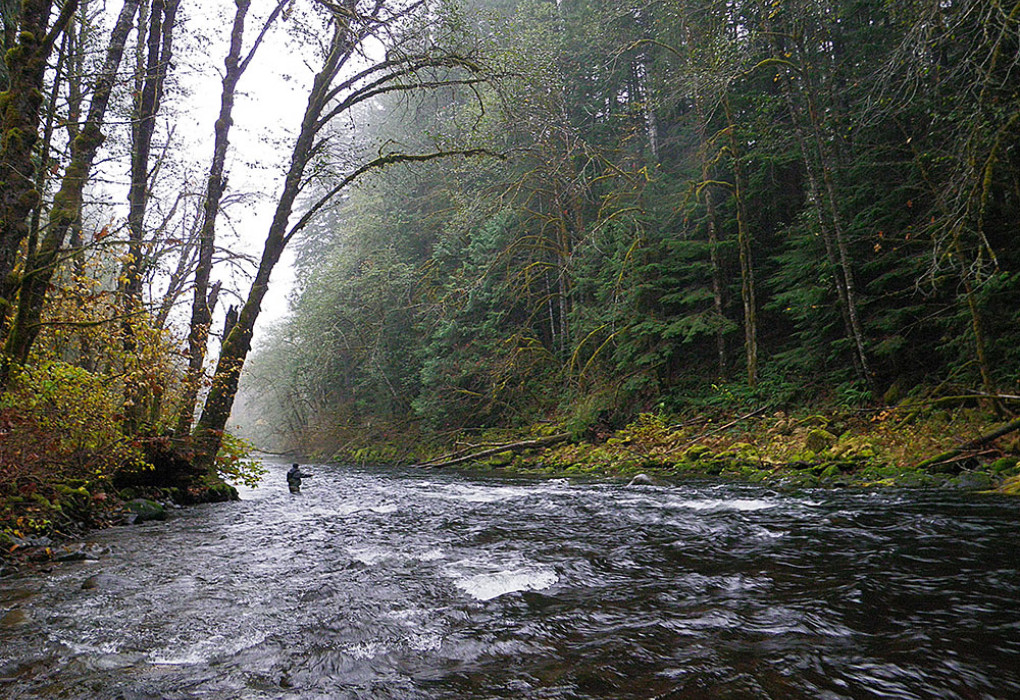Wind River: Wild Steelhead Management Zone
Then As It Was, So Shall It Be Again
History and Restoration
After a year of stakeholder meetings held by the Washington Department of Fish and Wildlife (WDFW), the Wind River is on track to become a Wild Steelhead Management Zone for wild summer steelhead. If achieved, this status will prevent the stocking of hatchery steelhead in the Wind River. Wild winter steelhead in Hamilton Creek and other Lower Gorge tributaries are also safe from hatchery programs, though they are not designated as Wild Steelhead Management Zones at this time.
The Wind River hatchery steelhead program was suspended in 1997 after extensive efforts by such visionaries as Bill McMillan, Bill Bakke and Randy Stetzer. In 1998, naturally produced steelhead in the Lower Columbia Distinct Population Segment (DPS) were given Threatened status under the Endangered Species Act. The 2009 removal of Hemlock Dam opened the way to 15 miles of critical spawning habitat in Trout Creek, a primary Wind River spawning tributary, which had been dammed with poor fish passage since 1935. Extensive riparian and stream channel habitat restoration work followed. In the years since, the numbers of spawning wild steelhead and redd counts have steadily increased, and although still lower than pre-dam estimates, significant recovery is indicated.
Rationale for Convening Stakeholders
Despite the considerable effort and expense to recover the Wind River’s wild summer steelhead, WDFW was under pressure by angling groups and locals to re-instate a steelhead hatchery program and/or steelhead kill fishery. The Gorge (Region 5) Steelhead Management Group was convened to set the course for policy and future status for wild steelhead within Washington’s Lower (Gibbons Creek – Hamilton Creek) and Upper (Rock Creek – Wind River) Columbia River Gorge tributaries. Biologists (state and federal), landowners, sport fishermen, Yakama Nation, Clark-Skamania Flyfishers and wild salmonid advocates were represented in the stakeholder group.
WDFW solicited input from the group on the following:
- natural production
- artificial production
- fisheries management
- regulatory compliance (enforcement issues)
- monitoring, evaluation & adaptive management
- research
- outreach & education
- summary of recommended actions
Current State of Columbia Gorge Steelhead
At present, there are no hatchery steelhead planted in either the Washington or Oregon side of the Columbia River Gorge. Limited hatchery programs in Hamilton Creek and Rock Creek were discontinued in the 1990’s. Any hatchery program initiated could potentially have widespread impacts on both Washington and Oregon wild populations, as Columbia Gorge steelhead tend to utilize watersheds on both banks of the river and the smolts planted would be outsourced from the Skamania Hatchery on the Washougal.
Lower Gorge winter steelhead populations are designated as Primary; meaning they are critical to recovery. Yet, little is known of actual population densities. In March of 2013, WDFW initiated spawning surveys on Hamilton Creek. If the population of wild winter steelhead in these small headwall tributaries can be determined as “self-sustaining” it may be possible to consider them as one population and establish them together as a Wild Steelhead Management Zone. Though not specifically recommended by the group, they will be managed as such. Due to the precarious nature of these runs, limited population data, extensive habitat restoration and the presence of chum salmon (Oncorhynchus keta), National Marine Fisheries Service (NMFS) will not issue permits for hatchery programs on any Lower Gorge stream. They are essentially off the table.
Wind River Wild Steelhead Management Zone
A summer steelhead Wild Steelhead Management Zone designation on the Wind precludes any further notions of re-instating a steelhead hatchery program in that watershed, winter or summer. There remains a U.S. Fish and Wildlife Service (USFWS) Spring Chinook program at the Carson Hatchery, which is subject to on-going scrutiny for potentially endangering naturally produced Wind River steelhead.
Rock Creek, which enters the Columbia in Stevenson, WA, has virtually no spawning habitat or vestigial steelhead populations due to a major barrier falls just up from the mouth. It has been selected by the group for a winter steelhead terminal fishery stocked with 20,000 Skamania winter steelhead smolts remaining from the segregated winter program on the White Salmon (the 24k summer steelhead that were planted in the White Salmon now go into Drano Lake), provided efforts are made to monitor/prevent stray hatchery fish from entering the Wind River.Net pens have been placed in Rock Creek lagoon to facilitate acclimation. PIT (passive integrated transponder) tagging these fish is not feasible at this time, but WDFW is confident that they will be able to identify strays at the Shipherd Falls trap (unless the trap is inundated with spring Chinook.)
Loss of Wind River steelhead in Bonneville Pool
Tracking data indicates a high loss of returning wild Wind River steelhead occurring in the Bonneville Pool. A percentage of out-migrating smolts are trapped on the Wind River each year and fitted with PIT tags. There is a PIT detection array at the Bonneville Dam fishway that records upstream passage of these fish as adults. As much as 60% of those fish never make it to Shipherd Falls, just 11 miles away. They do not turn up in any other watershed with PIT tag detectors, nor do they pass back below the dam or appear at other dams upriver.
This causes much consternation for WDFW. Possible explanations abound, including lethal water temperatures, incidental catch and release mortality in other fisheries, tribal fisheries or potential straying into streams not equipped with PIT tag arrays. WDFW is reviewing their research and monitoring methods to get a better handle on why this loss is occurring and determine if the 40 – 60% figure is accurate.
Angling Regulations
WDFW is adopting a “closed unless open” strategy for trout fishing in tributaries to protect juvenile steelhead statewide. It was the recommendation of the group that open status be limited to stream portions above barrier falls and all anadromous rearing waters remain closed for trout.
For steelhead, there were a variety of proposed management practices, largely dependent on the flawed notion that an escapement of 500 steelhead in the Wind constitutes “fully seeded”, meaning that all available rearing habitat will be utilized. At present, the carrying capacity goal for the watershed is approximately 25,000 smolts, the notion being that whether 500 adults spawn or 1500; the total number of smolts the watershed will support is 25,000.
Considering the Wind River historically hosted populations of adult steelhead upwards of 2,500 fish, this goal seems myopic. Where this measurement is of special concern pertains to the proposed three tier system for providing fishing opportunity.
Under this system, Tier I occurs if there are less than 500 spawners, the river would remain closed to angling. Tier II occurs if more than 500 steelhead passed Shipherd Falls the catch and release season would proceed with no kill provision. Tier III occurs when 750 – 1500 steelhead return indicating a “harvestable surplus” available for either an extension of the catch and release season, or a limited entry kill or trophy fishery. This Tier III strikes me as short-sighted and clearly places angler opportunity above the need to recover a wild steelhead population still listed as Threatened under the federal Endangered Species Act.
WDFW intends to conduct an analysis to further evaluate transitions between tiers and determine if 50% above seeding is sufficient to move from Tier II to Tier III. I suggested they look at historic numbers and shoot for a more natural carrying capacity figure five to six times higher than what they’re currently considering “fully seeded.” The caveat to this three tier notion is NMFS approval, which seems unlikely to be forthcoming. It is of critical importance that this proposal is met with strong opposition during the forthcoming public comment period.
At present, there is very little enforcement effort in the Lower Gorge and limited emphasis patrols on the Wind River. The group recommended extensive signage, particularly in campgrounds, pull-offs and boat ramps detailing hatchery vs. wild, seasons, boundaries and a poaching tip hotline. Signage should be linked to interpretive centers in campgrounds and appear on the camping reservation website. A landowner incentive program was highly recommended in addition to “stream watch” activities coordinated with law enforcement.
Winter Steelhead VSP Monitoring
One goal of WDFW is to increase Viable Salmonid Population (VSP) monitoring of wild winter steelhead, particularly in Hamilton Creek and Wind River. VSP determines abundance of adults and juveniles, diversity, productivity and spatial structure to measure long term status and trends. Evaluating hatchery strays and freshwater/marine effects on the population are vital components of VSP and are of particular interest in the Lower Gorge tributaries where any presence of hatchery fish would present a clear threat to existing wild steelhead populations. In addition to VSP, WDFW is developing biological reference points (BRP) to re-evaluate current escapement goals in the Gorge stratum. One can hope this will lead WDFW away from their current belief that 500 fish constitutes a “fully seeded” Wind River and toward a more historically grounded measurement of abundance.
Perseverance
The future of the Wind River and Lower Gorge tributaries lies in our public voice, our passionate and well-informed involvement in the continuing management process, the diligence of Native Fish Society members and volunteers in spawning surveys, outreach events, and increasing communications between conservation groups, wild salmonid advocates, political leaders and WDFW. Wild Steelhead Management Zone status for the Wind River would provide a long term anchor for Columbia Gorge wild steelhead. Extending this status for Lower Gorge tributaries, Hamilton Creek in particular, would be a bonus and well worth the effort. Thriving populations of wild steelhead are the vital bedrock of anadromous fish in our Gorge region and can be recovered to some shade of their former glory only through our persistence and dedication.
Peter Donahower is the Native Fish Society River Steward Regional Coordinator for the Mid-Columbia.



